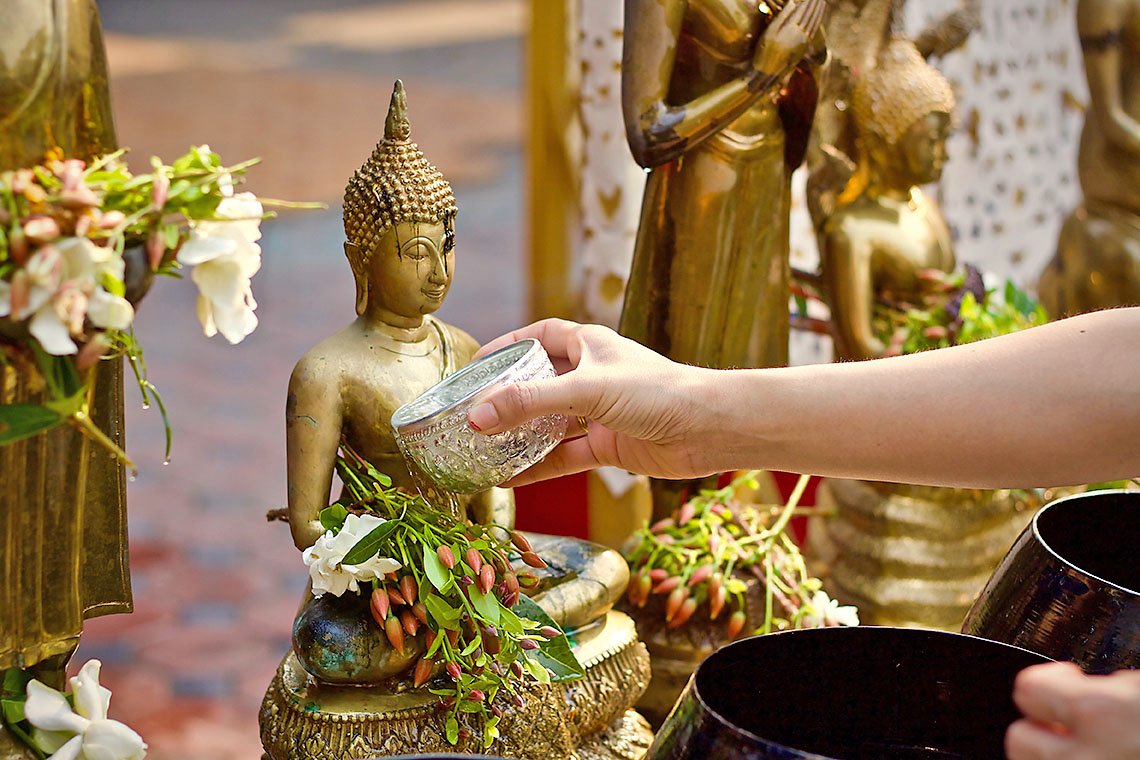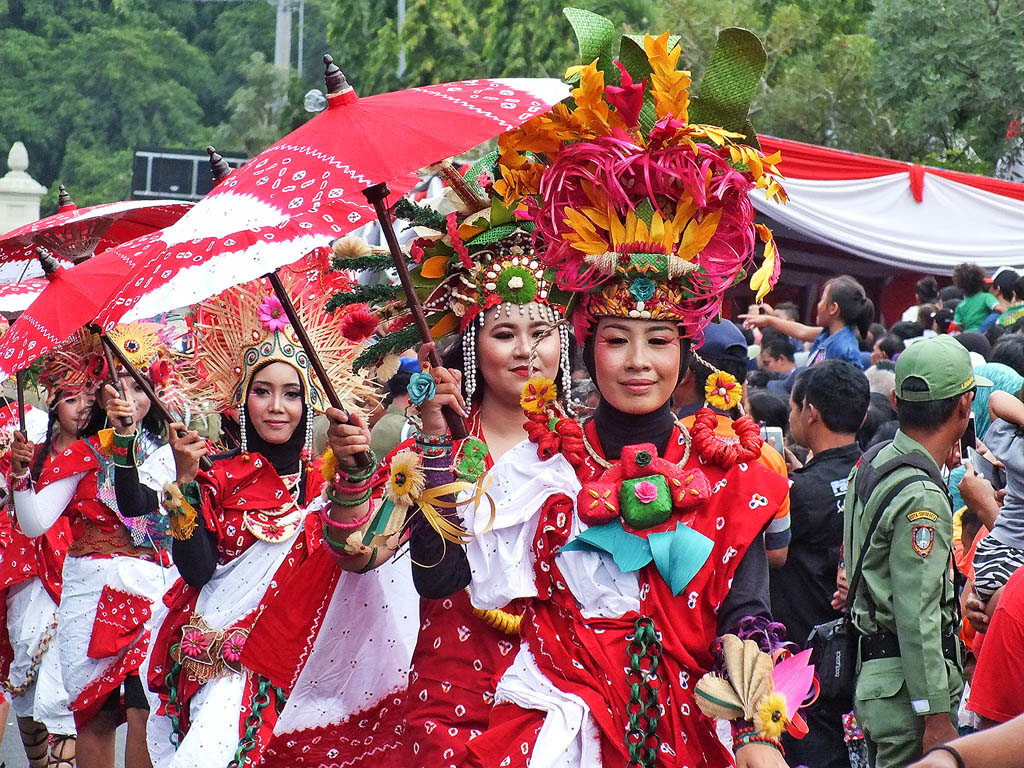Month by Month
TOP EVENTS
Buddhist New Year/Water Festival, April
Deepavali, November
Rainforest World Music, July
Ork Phansaa, October
Festival of the Nine Emperor Gods, October
January
Peak tourist season, cool and dry weather in mainland Southeast Asia and the Philippines. The east coast of the Malay peninsula (Samui Archipelago, Pulau Perhentian) and Indonesia are wet thanks to the northeast monsoon; low season in Bali.
zAti-Atihan
The mother of all Filipino fiestas, Ati-Atihan celebrates Santo Niño (Infant Jesus) with colourful, Mardi Gras–like indigenous costumes and displays in Kalibo, on the island of Panay.
zBun Pha Wet
This Lao-Buddhist festival commemorates the story of the Buddha-to-be. It’s considered an auspicious time to enter the monastery. Festivities are held in villages throughout Laos on varying dates.
zMyanmar’s Independence Day
The end of colonial rule in Burma is celebrated as a national holiday on 4 January.
zSultan of Brunei’s Birthday
Colourful official ceremonies are held on 15 January to mark the birthday of Sultan Hassanal Bolkiah.
zThaipusam
Self-mortification, including the carrying of portable altars mounted on spikes, marks the Tamil festival of Thaipusam, held in the lunar month of Thai in Kuala Lumpur and Singapore. Sometimes falls in February.
February
Peak season continues in mainland Southeast Asia and beaches are packed. The east coast of the Malay peninsula starts to dry off as the rains move further east; still raining in Bali.
zChinese New Year
This lunar festival (sometimes occurring in January) is celebrated in Chinese-dominated towns. In Penang, it’s a family affair and businesses close for one to two weeks. In Bangkok, Singapore, Phnom Penh and Kuching, there are dragon-dancing parades, food festivities and deafening fireworks.
zTet
Vietnam’s lunar New Year (sometimes occurring in late January) is the country’s biggest holiday, signalling the first day of spring. It involves family reunions, ancestor worship, gift exchanges, fireworks and lots of all-night luck-inducing racket. Travel is difficult; businesses close.
March
Mainland Southeast Asia is hot and dry; the beaches start to empty out. The winds kick up, ushering in kitesurfing season. In Bali, the northwest monsoon rains are subsiding to afternoon showers.
zEaster Week
This Christian holiday (sometimes in April) is observed in the Philippines, Vietnam, Indonesia, Melaka and Timor-Leste. Holy Week (Semana Santa) in the Philippines starts on the Wednesday before Easter Sunday. Expect lots of Spanish-influenced rituals such as fasting, penance and church-going.
zHindu New Year (Nyepi)
Bali’s ‘Day of Silence’ is marked by fasting and meditation; businesses and beach access close. The next day is the Balinese New Year’s Day, welcomed with night-time racket. Held 6 March 2019.
zMakha Bucha
One of three Buddhist holy days, Makha Bucha falls on the full moon of the third lunar month (usually in March, but sometimes in February) and commemorates Buddha preaching to 1250 enlightened monks. Celebrated at temples across Cambodia, Laos, Myanmar and Thailand.
April
The hottest time of year in mainland Southeast Asia makes inland sightseeing a chore. Cambodia, Laos, Myanmar and Thailand enjoy riotous traditional new year celebrations – make transport reserv-ations in advance. Shoulder season in Bali.
zBuddhist New Year (Water Festival)
In mid-April, Buddhist countries celebrate their lunar new year with symbolic water-throwing and religious observances. Celebrated with particular aplomb in Chiang Mai, Thailand, and in larger cities in Cambodia, Laos and Myanmar.

zVietnamese Liberation Day
The day US troops withdrew from Saigon (30 April) as North Vietnamese forces entered the city. Also called Reunification Day (and less complimentary names by overseas Vietnamese).
May
Still hot in mainland Southeast Asia but the end is in sight. May sees preparations for the upcoming rains and the start of rice-planting season. Northern Vietnam has spring-like weather and Bali is not yet crowded.
zIndependence Day (Timor-Leste)
One of the planet’s youngest nations, Timor-Leste celebrates Independence Day (20 May) with cultural events and sporting competitions.
zRamadan
The Muslim fasting month is observed in Malaysia, Indonesia, Brunei and parts of southern Thailand in the ninth month of the Islamic calendar (May to early June in 2019). Muslims abstain from food, drink, cigarettes and sex between sunrise and sunset. Idul Fitri marks the end of Ramadan.
zRocket Festival
Villagers fire off bamboo rockets (bang fai) to provoke rainfall for a bountiful rice harvest. Mainly celebrated in northeast Thailand and Laos; dates vary from village to village.
zRoyal Ploughing Ceremonies
In Thailand and Cambodia, this royal ceremony employs astrology and ancient Brahman rituals to kick off rice-planting season, blending Hindu and Buddhist traditions.
zVisakha Bucha
This Buddhist holy day, the 15th day of the waxing moon in the sixth lunar month, commemorates Buddha’s birth, enlightenment and parinibbana (death). Ceremonies, including the lighting of hundreds of candles, are held at temples throughout Cambodia, Laos, Myanmar and Thailand.
June
The southwest monsoon brings rain, usually an afternoon downpour, to most of mainland Southeast Asia and most of the Philippines. Summer holidays in Europe and China bring another tourist high season, especially in Bali.
zGawai Dayak
The end of the rice-harvest season is celebrated on the first two days of June in Sarawak (Malaysian Borneo). City-dwelling Dayaks return to their longhouses to socialise, feast and down shots of tuak (rice wine).
zHue Festival (Biennial)
Vietnam’s biggest cultural event is held every two years (2020, 2022 etc) in the one-time royal capital. Art, theatre, music, circus and dance performances are held inside Hue’s Citadel.
July
Mainland Southeast Asia prepares for Buddhist Lent, a period of meditation and contemplation coinciding with the rainy season (southwest monsoon). Despite the drizzle, this is an ideal time for rural sightseeing as rice planting begins. Thailand’s Samui archipelago often stays dry while other islands soak.
zAsanha Bucha
The full moon of the eighth lunar month commemorates Buddha’s first sermon, founding the Buddhist religion. Followers flock to temples to light candles, offer flowers and pray for good fortune. Celebrated at temples across Cambodia, Laos, Myanmar and Thailand.
zHM the King’s Birthday
This Thai holiday (28 July) hosts parades and merit-making events in honour of the king.
zKhao Phansaa
With the onset of the rainy season, Buddhist monks retreat into monasteries, and young men and boys are ordained as novices. Worshippers offer candles and donations at temples, particularly in Thailand and Laos, and Ubon Ratchathani (Thailand) celebrates with a grand parade.
August
The holiday season in Europe and China’s summer holiday ensure crowds across the region. Expect afternoon showers in most of mainland Southeast Asia, with a few all-day soakers. However, weather in Indonesia (especially Bali) is just right.
zHM the Queen’s Birthday
Thailand celebrates its queen’s birthday (and Mother’s Day) on 12 August.
zIndependence Day (Indonesia)
The country celebrates liberation from the Dutch on 17 August with large parades in Jakarta.

September
The rains ratchet up a gear in mainland Southeast Asia – flooding and boat cancellations are common. Occasional typhoons sweep in across Vietnam and the Philippines, sometimes wreaking havoc. Shoulder season in Bali.
zIslamic New Year
This lunar new year (known as Awal Muharram) in Indonesia and Malaysia is marked by fasting, self-reflection and commemoration of the martyrdom of Hussein ibn Ali. Held on 11 September 2018 and 1 September 2019.
zPchum Ben
In Cambodia, respects are paid to the dead through temple offerings. Many Khmers return to their home villages and try to visit seven temples in seven days. Most commonly held in September.
October
Mainland Southeast Asia prepares for the end of the rainy season and the end of Buddhist Lent. The northeast monsoon (affecting the east coast of the Malay peninsula and Indonesia) begins. Bali has occasional showers.
zFestival of the Nine Emperor Gods
In Thailand, this Taoist event is called the Vegetarian Festival, and is marked by abstinence from meat and other purification rituals. The most extreme is Phuket’s parade of entranced and pierced worshippers. Variations occur in Singapore, Malaysia and Myanmar. Sometimes held in September.
zOrk Phansaa
The end of the Buddhist Lent occurs three lunar months after Khao Phansaa. Merit-makers present new robes to the monks. Mysterious ‘naga fireballs’ are said to rise from the Mekong River, and riverside communities in Thailand and Laos celebrate with traditional boat races, particularly around Nong Khai.
November
The start of the month is shoulder season in mainland Southeast Asia, with cool, dry days and lush greenery all around. Northern altitudes see chilly night-time temperatures. The east coast of the Malay peninsula and Indonesia are in the midst of the rainy season.
zBon Om Tuk
This Cambodian festival (sometimes held in October) celebrates Jayavarman VII’s victory over the Chams in 1177 and the reversal of the Tonlé Sap river. Boat races stir local patriotism and crowds gather in Phnom Penh and Siem Reap.
zBun Pha That Luang
Laos pays tribute to its iconic stupa in Vientiane with a week-long festival coinciding with the full moon.
zDeepavali
Hindus across the region celebrate the festival of lights to mark the triumph of good over evil. Tiny oil lamps are ceremoniously lit in Malaysia, Thailand and Bali, and Singapore’s Little India hosts public festivities. Sometimes occurs in October.
zLoi Krathong
During November’s full moon, Thais launch illuminated banana-leaf boats in honour of the river goddess. In Chiang Mai, for the linked festival of Yi Peng, floating paper lanterns are released into the sky. A similar tradition is practised in Myanmar during the fire-balloon competitions in Taunggyi.
zProphet Mohammed’s Birthday
The birthday of Islam’s holy prophet is celebrated in the third month of the lunar-based Islamic calendar (21 November 2018 and 10 Nov-ember 2019) with religious prayers and processions.
December
This is mainland Southeast Asia’s busiest tourism season. The weather is fine; rain is tapering off on the Samui archipelago but still falling in Bali.
zChristmas
Christmas is particularly important for Catholic communities in the Philippines, Timor-Leste, Indonesia and Vietnam. It’s a serious celebration, with important religious services and ceremonies.
zLao National Day
On 2 December Laos celebrates the 1975 victory over the monarchy and the establishment of the Lao People’s Democratic Republic.